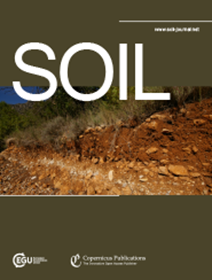苔藓恢复对温带葡萄园土壤侵蚀和土壤含水量的影响
IF 5.8
2区 农林科学
Q1 SOIL SCIENCE
引用次数: 0
摘要
摘要水土流失是世界范围内的一个严重问题,因为它危及土壤肥力,进而危及粮食安全。与此同时,农业本身也是造成水土流失的最大因素之一,尤其是葡萄园,由于山坡陡峭、土壤脆弱和管理方法不当,很容易造成水土流失。因此,寻找替代管理方法变得至关重要。植被覆盖可以减少土壤侵蚀,这一点同样适用于苔藓覆盖。然而,利用苔藓作为侵蚀控制手段来恢复和保护裸露土壤的研究仍处于起步阶段。本研究通过在温带葡萄园中应用人工栽培的苔藓垫,对苔藓的恢复进行了调查。在一年中的三个测量时间(4 月、6 月和 10 月),通过模拟降雨,考察了苔藓恢复对地表径流和沉积物排放的影响,并与裸土和覆盖作物进行了比较。此外,在所有降雨模拟过程中,还对每种处理的土壤含水量进行了监测。苔藓最初在夏季表现出相当程度的干燥,随后生长速度下降。到了 10 月份,苔藓恢复并重新在葡萄园中生长,表现出很强的抵抗力。与裸露的土壤相比,苔藓的恢复大大减少了 71.4% 的地表径流和 75.8% 的沉积物排放。与覆盖作物相比(分别为 68.1% 和 87.7%),苔藓修复在减少径流方面的效果略好,而在减少侵蚀方面的效果略低,但这些差异在统计学上并不显著。苔藓恢复的沉积物排放量随季节而变化,尤其是在 4 月至 6 月,这很可能是由于 6 月苔藓覆盖率下降和藤本植物叶片减少,藤本植物叶片和木质表面形成了集中的树冠滴点,加剧了侵蚀。在 4 月和 6 月,不同处理对土壤含水量的影响不大,而在 10 月,裸土的土壤含水量最高,苔藓修复的土壤含水量最低。由此可见,土壤覆盖的影响因季节而异,在较干旱的夏季,苔藓恢复对土壤含水量没有不利影响,但在 10 月份,土壤含水量最少。总体而言,苔藓恢复被证明是一种合适且维护成本低的侵蚀控制替代方法,因为它不需要修剪,也不会降低夏季近地表的土壤含水量。本文章由计算机程序翻译,如有差异,请以英文原文为准。
Effects of moss restoration on soil erosion and soil water content in a temperate vineyard
Abstract. Soil erosion is a serious problem worldwide, as it jeopardizes soil fertility and thus food security. At the same time, agriculture itself is one of the biggest drivers of soil erosion, and vineyards in particular are vulnerable due to often steep slopes, fragile soils, and management practices. Therefore, the search for alternative management practices becomes vital. Since soil erosion is reduced by vegetation cover, this also applies to moss cover. However, research on the restoration and protection of bare soil using mosses as erosion control is still in its infancy. In this study, the restoration of mosses was investigated by applying artificially cultivated moss mats in a temperate vineyard. The effects of moss restoration on surface runoff and sediment discharge were examined compared to bare soil and cover crops using rainfall simulations at three measurement times during one year (April, June, and October). Additionally, soil water content was monitored for each treatment during all rainfall simulations. Mosses initially showed considerable desiccation in summer, whereupon their growth declined. In October, the mosses recovered and re-established themselves in the vineyard, showing a high level of resistance. Moss restoration significantly reduced surface runoff by 71.4 % and sediment discharge by 75.8 % compared to bare soils. While moss restoration had a slightly better effect on reducing runoff and a slightly lower effect on reducing erosion than cover crops (68.1 % and 87.7 %, respectively), these differences were not statistically significant. Sediment discharge varied seasonally for moss restoration, especially from April to June, which is most likely due to the decline in moss cover and the foliage of the vines in June, as concentrated canopy drip points have formed on the leaves and woody surfaces of the vines, increasing erosion. In April and June, the different treatments do not significantly impact soil water content, while in October, bare soil had the highest and moss restoration the lowest soil water content. According to this, the influence of soil cover varies seasonally, with moss restoration not having a detrimental effect on the soil water content in the drier summer months, but retaining the least water in October. Overall, moss restoration proved to be an appropriate and low-maintenance alternative for erosion control, as it requires no mowing and does not reduce near-surface soil water content during summer.
求助全文
通过发布文献求助,成功后即可免费获取论文全文。
去求助
来源期刊

Soil
Agricultural and Biological Sciences-Soil Science
CiteScore
10.80
自引率
2.90%
发文量
44
审稿时长
30 weeks
期刊介绍:
SOIL is an international scientific journal dedicated to the publication and discussion of high-quality research in the field of soil system sciences.
SOIL is at the interface between the atmosphere, lithosphere, hydrosphere, and biosphere. SOIL publishes scientific research that contributes to understanding the soil system and its interaction with humans and the entire Earth system. The scope of the journal includes all topics that fall within the study of soil science as a discipline, with an emphasis on studies that integrate soil science with other sciences (hydrology, agronomy, socio-economics, health sciences, atmospheric sciences, etc.).
 求助内容:
求助内容: 应助结果提醒方式:
应助结果提醒方式:


